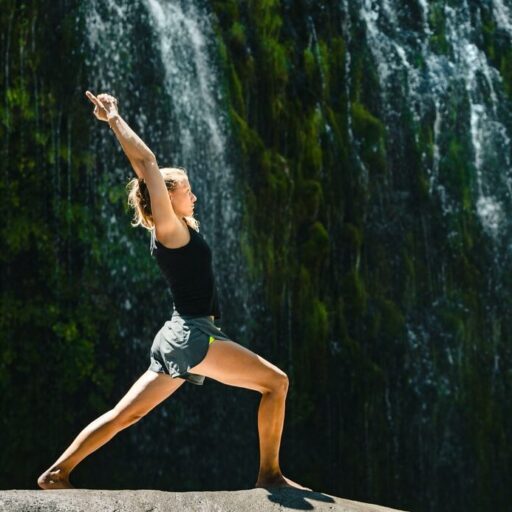Support our educational content for free when you purchase through links on our site. Learn more
Green Exercise: The Ultimate Guide to Fitness in Nature [2024]
Quick Answer: Green exercise refers to physical exercise undertaken in natural environments. It provides numerous physical and psychological health benefits, including stress reduction, improved mood, increased self-esteem, and enhanced cognitive function. Engaging in green activities such as hiking, gardening, and outdoor sports can have a positive impact on overall well-being. In this comprehensive guide, we’ll explore the background, benefits, and examples of green exercise, as well as answer frequently asked questions and provide recommendations for incorporating green exercise into your fitness routine.
Table of Contents
- Quick Answer
- Quick Tips and Facts
- Background: The Power of Nature
- Benefits of Green Exercise
- Types of Green Activities
- Examples of Green Exercise
- FAQ
- Conclusion
- Recommended Links
- Reference Links
Quick Answer
Green exercise is the practice of engaging in physical exercise in natural environments. It offers a wide range of physical and psychological health benefits. Research has shown that spending time in nature can reduce stress, improve mood, boost self-esteem, and enhance cognitive function. Green exercise can take various forms, including hiking, gardening, outdoor sports, and nature walks. By incorporating green exercise into your fitness routine, you can enjoy the beauty of nature while reaping the rewards of a healthier mind and body.
Shopping Links: CHECK PRICE on: Amazon | Shop Walmart | Shop Etsy
Quick Tips and Facts
- Green exercise refers to physical exercise undertaken in natural environments.
- Spending time in nature has been shown to reduce stress and improve mood.
- Engaging in green exercise can boost self-esteem and enhance cognitive function.
- Green activities such as hiking, gardening, and outdoor sports are popular forms of green exercise.
- Incorporating green exercise into your fitness routine can provide a refreshing change of scenery and improve overall well-being.
Background: The Power of Nature
Nature has a profound impact on our well-being. The sights, sounds, and smells of the natural world have a calming effect on our minds and bodies. The concept of green exercise recognizes the power of nature in promoting physical and psychological health. It emphasizes the importance of engaging in physical activity in natural environments to maximize the benefits of exercise.
Green exercise has its roots in well-established areas such as the attention restoration theory within environmental psychology and the psychological benefits of physical exercise. Research has shown that viewing, being in, and interacting with natural environments can reduce stress, increase the ability to cope with stress, reduce mental fatigue, and improve concentration and cognitive function.
Benefits of Green Exercise
Engaging in green exercise offers a multitude of benefits for both the body and mind. Here are some of the key advantages:
1. Stress Reduction
Spending time in nature has a calming effect on the nervous system, helping to reduce stress levels. The peacefulness and tranquility of natural environments can provide a much-needed escape from the pressures of daily life. Whether it’s a leisurely walk in the park or an intense hike in the mountains, green exercise can help you unwind and find inner peace.
2. Improved Mood
Nature has a way of lifting our spirits and boosting our mood. Research has shown that spending time in green spaces can increase feelings of happiness and well-being. The combination of physical activity and exposure to nature’s beauty releases endorphins, the body’s natural feel-good chemicals. So, the next time you’re feeling down, head outside for a dose of green exercise to lift your spirits.
3. Increased Self-Esteem
Engaging in physical activity in natural environments can have a positive impact on self-esteem. The sense of accomplishment that comes from conquering a challenging hike or completing a workout in a scenic setting can boost your confidence and self-worth. Green exercise allows you to push your limits and discover the strength within you, leading to a greater sense of self-esteem.
4. Enhanced Cognitive Function
Nature has a rejuvenating effect on the brain, improving cognitive function and mental clarity. Research has shown that spending time in green spaces can enhance attention, memory, and creativity. The combination of fresh air, natural light, and the absence of distractions in natural environments allows the brain to recharge and function at its best. Incorporating green exercise into your routine can help you think more clearly and perform better in other areas of life.
5. Physical Fitness
Of course, one of the primary benefits of green exercise is improved physical fitness. Whether you’re hiking, biking, or playing outdoor sports, engaging in physical activity in natural environments provides a unique and enjoyable way to stay fit. The varied terrain and challenges of outdoor environments can help improve cardiovascular health, build strength and endurance, and burn calories. Plus, the beauty of nature serves as a motivating backdrop, making exercise more enjoyable and sustainable.
Types of Green Activities
Green exercise encompasses a wide range of activities that can be enjoyed in natural environments. Here are some popular types of green activities:
1. Hiking and Trail Running
Hiking and trail running are excellent ways to immerse yourself in nature while getting a great workout. Whether you prefer leisurely walks through scenic trails or challenging ascents to mountain peaks, hiking and trail running offer a unique opportunity to explore the beauty of natural landscapes while improving your fitness.
2. Gardening
Gardening is not only a relaxing and rewarding hobby but also a form of green exercise. Tending to plants, digging in the soil, and maintaining a garden can provide a full-body workout. Gardening activities such as planting, weeding, and watering engage various muscle groups and promote flexibility and strength.
3. Outdoor Sports
Engaging in outdoor sports such as soccer, basketball, tennis, or golf allows you to enjoy the benefits of green exercise while having fun with friends or family. Playing sports in natural environments adds an extra element of excitement and challenge, making the experience more enjoyable and memorable.
4. Nature Walks
Nature walks are a simple yet effective way to incorporate green exercise into your routine. Whether it’s a leisurely stroll through a local park or a more challenging hike in a nature reserve, walking in natural environments provides numerous health benefits. Take the time to observe and appreciate the beauty of your surroundings as you engage in this gentle form of exercise.
5. Outdoor Yoga and Meditation
Practicing yoga or meditation in natural environments can enhance the benefits of these mindfulness practices. The combination of physical movement, deep breathing, and the serenity of nature creates a harmonious experience for the mind, body, and soul. Find a peaceful spot outdoors and connect with the earth as you stretch, breathe, and find inner peace.
Examples of Green Exercise
Green exercise can take many forms, and there are countless examples of how people incorporate it into their lives. Here are a few inspiring examples:
1. Green Gyms
Green gyms are outdoor fitness spaces that provide a unique alternative to traditional indoor gyms. These outdoor workout areas are often located in parks or natural settings and offer a range of exercise equipment designed to be used in the open air. Green gyms provide an opportunity to enjoy the benefits of green exercise while engaging in strength training, cardio workouts, and other fitness activities.
2. Barefoot Running
Barefoot running, also known as natural running, involves running without shoes or with minimalist footwear. This practice allows the feet to move more naturally and strengthens the muscles and connective tissues of the lower limbs. Many barefoot runners prefer to run on natural surfaces such as grass or trails to experience the added benefits of green exercise.
3. Walk and Talk Groups
Walk and talk groups bring people together for a combination of exercise and conversation. These groups meet in natural settings and engage in leisurely walks while discussing various topics. Walk and talk groups provide an opportunity to connect with others, enjoy the beauty of nature, and improve both physical and mental well-being.
FAQ
What is considered green exercise?
Green exercise refers to physical exercise undertaken in natural environments. It involves engaging in activities such as hiking, gardening, outdoor sports, and nature walks. The key aspect of green exercise is the incorporation of natural settings, which enhances the physical and psychological benefits of exercise.
What are the effects of green exercise?
Green exercise has numerous effects on both the body and mind. It can reduce stress, improve mood, boost self-esteem, enhance cognitive function, and promote physical fitness. Spending time in nature has a calming effect on the nervous system and releases endorphins, leading to improved well-being.
Read more about “… How Does Nature Affect Physical Health? The Ultimate Guide”
What are some green activities?
Some popular green activities include hiking, gardening, outdoor sports, nature walks, and outdoor yoga or meditation. These activities allow individuals to engage in physical exercise while enjoying the beauty of natural environments. Green activities provide a refreshing change of scenery and offer unique challenges and rewards.
Read more about “6 Benefits of Exercising in Nature …”
What is the green activity?
The green activity refers to any form of physical exercise undertaken in natural environments. It encompasses a wide range of activities, from leisurely walks in the park to intense hikes in the mountains. The green activity promotes the integration of exercise and nature, maximizing the benefits for both physical and psychological health.
Read more about “… How Does the Environment Affect Physical Activity?”
Conclusion
Green exercise offers a unique and refreshing approach to fitness, combining physical activity with the beauty of nature. Engaging in green activities such as hiking, gardening, and outdoor sports can have a profound impact on overall well-being. The stress-reducing, mood-boosting, and cognitive-enhancing effects of green exercise make it an ideal choice for those seeking a holistic approach to fitness.
Incorporating green exercise into your routine can provide a much-needed escape from the pressures of daily life and allow you to reconnect with the natural world. Whether you prefer the tranquility of a nature walk or the exhilaration of a challenging hike, there are endless possibilities for enjoying the benefits of green exercise.
So, lace up your hiking boots, grab your gardening tools, or gather your friends for a game of outdoor sports. Embrace the power of nature and let green exercise transform your fitness journey. Your mind, body, and soul will thank you.
Recommended Links
- Ocean Swimming Safety: Explore the safety guidelines and tips for ocean swimming.
- Climate Aware Fitness: Discover how to stay fit while being mindful of the environment.
- Nature Meditation Practices: Learn about different meditation techniques to connect with nature.
- Fitness Gear Reviews: Find in-depth reviews of fitness gear to enhance your workouts.
CHECK PRICE on: Amazon | Shop Walmart | Shop Etsy | Brand Official Website
Reference Links
- Green exercise – Wikipedia: Explore more about the concept of green exercise and its benefits.
- Ecopsychology: Learn about the field of ecopsychology and its connection to green exercise.
- Green Gym: Discover the concept of green gyms and their role in promoting green exercise.
- Green prescription: Find out about green prescriptions and how they encourage physical activity in natural environments.
- Horticultural therapy: Learn about the therapeutic benefits of gardening and horticultural activities.
- Care farming: Explore the concept of care farming and its role in promoting well-being through green exercise.
- Forest bathing: Discover the practice of forest bathing and its benefits for mental and physical health.
Remember, by incorporating green exercise into your fitness routine, you can enjoy the beauty of nature while reaping the rewards of a healthier mind and body. So, step outside, embrace the power of nature, and let green exercise transform your fitness journey.




